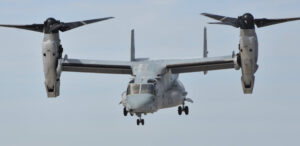Russia’s 40-mile-long military convoy will be one of the enduring images of the conflict in Ukraine. Broad ridicule of the convoy as evidence of the Russian military’s inability to sustain its invasion forces is well-deserved, but the images are eerily reminiscent of my personal experience in Iraq nearly 20 years ago. As tempting as it can be to focus on our adversaries’ failures, we must take an objective view of our own operations to avoid similar mistakes in the future.
Twenty years after the U.S.-led coalition invades Iraq, specific lessons and experiences stand out, particularly in the context of the conflict in Ukraine and growing tensions in the Indo-Pacific. One thing is clear: how we executed sustainment convoys and related missions then won’t work in an environment where persistent intelligence, surveillance and reconnaissance and low-cost, precision strikes from unmanned, often-commercially available drones or man-portable anti-tank weapons are so readily available.
In the first 100 days of our campaign in Iraq, I served as an intelligence officer of a brigade-level sustainment headquarters. Stationed in an assembly area south of Kuwait’s border, our mission was to advance north and provide logistical support to combat units advancing toward Baghdad. Over the next two weeks, my unit crept forward on a single highway and merged with hundreds of vehicles from other teams into a miles-long convoy laden with tons of fuel, ordnance and troops.
There was no hiding thousands of slow-moving vehicles stretched through the open desert. Complicating matters, a sandstorm of biblical proportions halted the convoy’s progress for over 24 hours. Most vehicles in our movement lacked even the most basic communications equipment to monitor the operation and enemy activity in our immediate area. Our lack of mobility compounded our lack of situational awareness about enemy activity and friendly forces. Since the unit had no organic reconnaissance capability, we could not identify alternate routes or assess options for off-road mobility. Finally, continuous operations inevitably resulted in crew exhaustion, dramatically increasing the probability of error.
A harsh wakeup call for the U.S. on sustainment
This experience was not entirely unlike Russia’s now-infamous convoy into Kyiv. The hollowed-out carcasses of tanks and supply trucks along Ukraine’s highways should serve as a harsh wake-up call as we think about how the United States will sustain its forces on the modern battlefield, not only as a talking point about the ineffectiveness and disorganization of Russia’s military.
Avoiding disaster on future battlefields requires us to learn from our experiences in Iraq and observations of Ukraine’s conflict. We conducted that convoy through Southern Iraq with the same equipment and tactics our unit employed in 1991, during Operation Desert Storm. Our eventual success resulted from the courage and resiliency of the soldiers serving during that critical but often overlooked operation.
However, against a more capable adversary, the “mother of all convoys” could have been disastrous. What can we do?
Networked human-machine teams address many challenges our forces will face on the modern battlefield. Autonomous systems present an economy of force that allow commanders to prioritize service members for other, more pressing tasks, preserving combat power by minimizing their exposure to high-risk missions.
The broad benefits of autonomous systems
For example, aerial and ground-based autonomous systems can reconnoiter alternate on- and off-road routes while service members focus on local security and conduct mission planning, increasing the speed and quality of decision-making and allowing convoys to sustain movement tempo.
Autonomous systems also let crews operate remotely controlled operations without being in the vehicle, much like with the Army’s Robotic Combat Vehicle (RCV) currently under development. This presents a wide range of possibilities for tactical employment, not least of which is the ability to distribute forces during maintenance and security halts, such as those that characterized our movements in the early days of Operation Iraqi Freedom.
The Department of Defense deserves enormous credit for enacting efforts to rapidly modernize across 14 critical technology areas, including trusted artificial intelligence and autonomy. After spending a decade and billions of dollars doing autonomy research for ground vehicle, maritime surface and subsurface and aerial platforms, the department is finally transitioning major research efforts to programs of record for procurement. The Air Force’s Collaborative Combat Aircraft (CCA) program and the RCV serve as pathfinders for the Department.
But similar investments in autonomous systems supporting sustainment operations are lagging. For example, the Army’s Common Tactical Truck (CTT) program consists of a family of vehicles designed to replace the vehicles that made up the “mother of all convoys” in Iraq. Current requirements for CTT call for the platform’s electrical, physical and logical interfaces to support autonomy upgrades post-production. This approach is at odds with private sector best practices that call for autonomy programs to incorporate a software development and sustainment pipeline throughout the vehicle’s entire lifecycle, not just after production.
The good news is that the Army is already incorporating industry best practices in the RCV program, something of tremendous value to other programs building autonomous systems.
By examining these lessons, and those of past operations, we take an essential first step in ensuring our military sustainers do not have to fight the next war with equipment and tactics more akin to Operation Iraqi Freedom than what will be required to survive on the modern battlefield.






